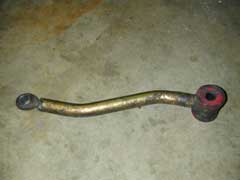
Front Axel Torque Tube
Purpose of the torque tube on the Toyota truck is to prevent the axel from rotating under braking loads. If the axel rotates during braking, the rotating action would cause the steering linkage to steer the wheels due to the geometry of the steering linkage. By changing the steering system to crossover steering, the effect of steering during braking can be eliminated. For my truck, I choose to retain the stock steering since with only 2.5" of lift, there are not much stress on the stock steering system. Retaining the stock steering means I need to use the torque tube.
However, on my truck, the tube was too long both before and after the OME suspension lift. This must be due to manufacture tolerance in the suspension, or bending of the spring perch which changed the caster angle of the axel. For whatever reason, I was not going to change ths caster angle of the axel since the truck steered fine. The original torque tube could have been forced into place, but changing the length of the torque tube would be a more durable approach to minimize bushing compression wear, and stress on parts.

This is the Rancho aftermaket torque tube that was installed on the truck for about 60k miles. I got it because the length can be adjusted. It was quite expensive at about $80, and was not a good product for reasons explained below. I would not recommend it. This is an example of how aftermarket parts are usually not up to OEM standard.
This is the side by side pictures of the end bushing on the Rancho torque tube on left, and OEM on right.
What's wrong with the picture on the left?
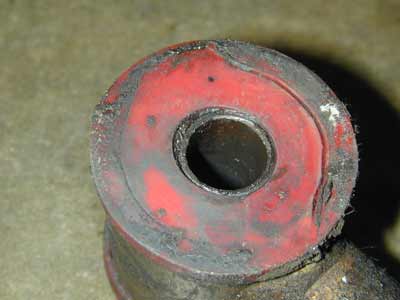
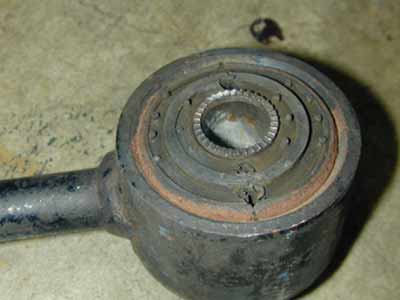
1. The Rancho torque tube use poly bushing which tend to squeak after a period of time. That is more of an irritant than a real concern.
2. The tubing in the center of the bushing was too short by maybe .1" Rancho must be too cheap to cut a longer piece of tubing, or they don't know how to measure. This cause the ears of the mounting tabs on the frame to bend inward, and deform the poly bushing. The bent tabs also mean that the tabs are not seated flat agains the tubing. Without a good seating surface, the tubing can move and twist around within its clearance.
3. The third problem is that the edge of the tubing on the Rancho tube is smooth, while the OEM tube has serration on it. There was a purpose for the serration on the OEM tubing. It is to grip the mounting tabs that the torque tube attaches to to prevent slippage. Over time the slippage on the Rancho piece would wear the mounting tabs on the truck. With material gone, the bolt tension would loosen over time. That was pretty much what happened in my case.
None of these problems are show stoppers, but it just shows how typical aftermarket parts do not pay attention to details. For best reliability and durability, I decided to go back to modify the OEM tube.
The other end on the Rancho torque tube. The threaded rod end is a good idea with some limtations. The amount of swivel on the ball is limited to about 13 degrees before interference with the supplied spacer. Once length adjustment is set, the lock nut is tightened. However, the locking nut on the rod end will never have enough tension to prevent the rod end from turning once angular travel on the rod end is used up. This may not be a problem for most rigs, but for suspensions with lots of articulation, the rod end will loosen. This is the same reason I would not modify the stock torque rod into an adjustable one with a stud and two nuts. The twisting torque from articulation of the suspension will loosen the lock nuts. The nuts cannot loosen all the way since the rod can turn only so much. However, now the threads will be another wear point on the suspension. Something it is not designed for.
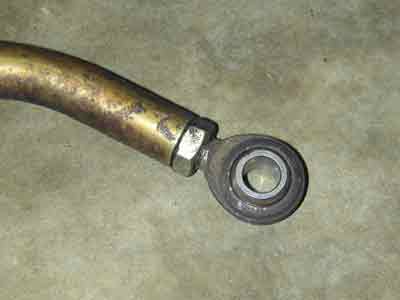
Due to the problems with the Rancho torque tube, is back again to the OEM tube. I decided to bend the torque tube in a "Z" shape to reduce its length, and to add clearance.
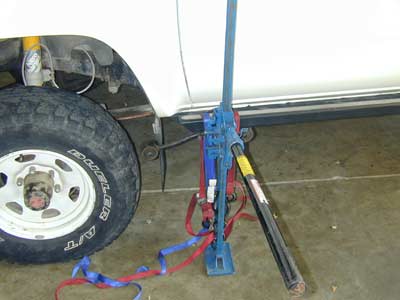
In classic shade tree mechanic style, I used the hyjack along with tie downs on the rocksliders to bend the torque tube. Despite the tremendous load placed on the rockslider with me standing on the hyjack lever, they held up nicely. Hardly any scratched paint.

This is the finished result. Fits perfectly. It does not have the pretty bends, but it works.
Update:
The OEM torque rod was too long. After driving the car for a while, I realize why Toyota engineers made the rod too long. It is suppose to pre-compress the bushing. During braking, the axel tilts forward, and because of the position of the sterring drag link, it results in steer to the right. Each time you step on the brake hard, the car steers to the right. The torque tube was suppose to keep the car from steering to the right when you brake. It is purposely made to be too long to put the bushings in compression to keep the axel from rotating. If I have to do it over again, I would leave the torque tube as is. Don't bend it to correct for the length difference.